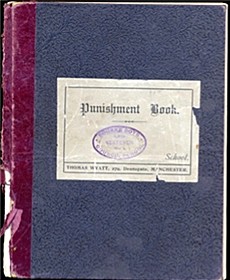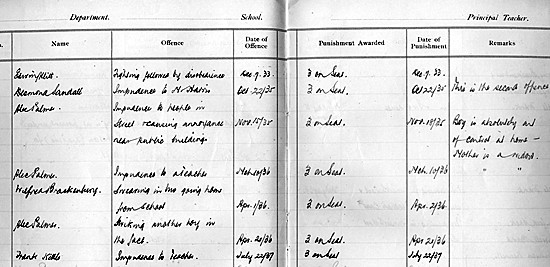Spare the rod and spoil the child was a popular belief in 19th century England, one that had biblical origins because the old adage on discipline is an adaptation of six verses from Proverbs 13 rather than an exact quotation. Nevertheless, the meaning was intended to be that if one does not discipline a child, he or she will never learn obedience and good manners and so corporal punishment such as caning became a common practice at schools in England until outlawed by act of Parliament in 1987. Until then, teachers frequently disciplined wayward pupils physically, usually with a flexible rattan cane applied either to the hands or, especially in the case of teenage boys, to the seat of the trousers. Slippering was also widely used as a less formal alternative and in some schools a strap was used instead of the cane. Literature abounds with vivid descriptions of the practice, particularly in the works of the Victorian novelist Charles Dickens, where caning was taken to barbaric lengths in some institutions, and it is surprising that it continued well into the 20th century. Our own schools in Bourne were no exception and evidence that this extreme form of discipline was still practiced in recent years comes in a Punishment Book covering a sixty-year period that has survived, beginning in 1923 with the Bourne Boys Council School in what was then Star Lane (now the Bourne C of E Primary Academy in Abbey Road) with continuing entries as the senior school moved to separate premises in Queen's Road in 1946, later becoming Bourne County Secondary School and then the Robert Manning College (now Bourne Academy). The book (pictured above) was compiled during the headships of Harry Goy (1920-46), Leslie Day (1946-68), Howard Bostock (1968-80) and Louis Decamp (1980-84) and gives an insight into the method of discipline enforced when the school was under their control. During the period from April 1923 until the record closed in April 1984, there are over 600 entries, an average of ten punishments a year, with one, two or three strokes of the cane for offences such as unruly behaviour and being abusive to the staff. The usual procedure when a pupil transgressed was that the teacher sent him to the headmaster and he carried out the caning in his study. Some boys did regard it with a sense of bravado but there was also a social stigma to bear within his own circle for anyone who was punished in this way. Each pupil in the Punishment Book is named and for anyone who knows Bourne well, many will be recognisable as people who still live in the town and so in those entries which I have quoted, only the initials are given to save them from embarrassment over their juvenile misdemeanours. Offences during 1923 which resulted in caning included continual disobedience or misbehaviour, impudence to a teacher, using bad language, vulgarity, indecent talk, inattention and truancy. In 1925, G O was caned for "absolute cheek" to a teacher while two pupils, E M and C R were punished for "playing noughts and crosses during geography" and V R for being "repeatedly untruthful". The following year, J R received two strokes of the cane on his seat because he "threw a lighted match through the window into the school and was impudent to his teacher". In the case of G B, one offence led to another because in 1926, he "ran home when sent to me and played truant in the afternoon and wrote indecently on a piece of paper" although he got off lightly with only two strokes of the cane. T S was caught "smoking on school premises during the dinner hour" and in 1929, G J was given three strokes for "bullying in the playground after being repeatedly warned and was then cheeky when corrected". In the same year, C B must have been a hungry pupil because he was given three strokes on the seat for "stealing dinner" on three occasions. In 1931, R D got two strokes for "writing filthy notes" while J W was punished for "absolute laziness" (three strokes) and in 1935, A P was caned for "impudence to people in the street and causing annoyance near public buildings" (three strokes). In 1937, H D was caned for "climbing into the lavatories and breaking into the tanks" (four strokes). J W was singled out for special punishment in 1938 and was eventually sent to the headmaster for "impudence to a teacher followed by misbehaviour in the woodwork room". He was given four strokes on the seat and the headmaster duly noted: "This boy has been looking for trouble for some considerable time." The punishments continued through the years, usually insolence, disobedience and truancy, although today the offences may be regarded as high jinks by teenagers rather than serious wrongdoing although they did break the school rules and it was considered necessary to maintain discipline if the system was to continue working efficiently. All of the punishments involved boys and so we tend to forget that this was a co-educational school but we are reminded of this by an entry in October 1968 when M S was given one stroke of the cane on the seat for "interfering with a girl causing bruising on her" although we are not told exactly what happened. The following month, there is evidence that pupils were looking forward to Guy Fawkes' Night because R W and B L were both caned (one stroke each) for "setting off fireworks at break time". By 1980, the offences remained largely mischievous and adventurous such as smoking and swearing although A F was caned (one stroke) for throwing an egg at a teacher, K F for "frightening another boy" (one stroke), M B for "writing an offensive remark" (two strokes) and J L for "removing a door handle" (two strokes). Two lads who played truant in 1983 also got two strokes each after the headmaster recorded that their excuse was "a cock and bull story". Punishments were becoming less severe with most pupils receiving only one stroke of the cane each while the majority of the offences were quite trivial. The climate of caning therefore appears to have been receding. There was also some concern about pupils being punished for their conduct after they had left school. In 1970, for instance, R R and P F had been caned for assaulting a schoolgirl at Cawthorpe while in the same year, three boys, P C, C B and M F had been punished for insulting a lady in Queen's Road (one stroke each) and in 1981, D L was caned for "smoking on a school bus" (two strokes). This raised the question of how far the headmaster's authority extended outside the school premises, an issue which was addressed by the county education authority which sent out a directive advising what to do in such circumstances: "A headmaster has received a complaint from a firm of solicitors on behalf of parents whose child sustained minor injuries in a scuffle on her way home from school. We are advised that a schoolmaster has no legal responsibility for the behaviour of his pupils when they are off the school premises on their journey from school to home. At the same time, a headmaster will always be concerned with the conduct of his pupils and will take such steps as lie within his power to see that no pupil commits a nuisance. If there is any question of legal action, it is a matter for the parents and the headmaster should be careful to obtain the consent of the parents before he questions pupils as the matter may be considered to be sub judice." No further cases of punishment for pupils in trouble outside school are therefore recorded. The last entry in the book is dated 28th March 1984 when four fourth-year boys were give three strokes each for "out of school interference with a girl", a punishment agreed with the parents. This is the only entry in the book which refers to the involvement of parents and indicates a change in the climate of public opinion over school punishment. Caning also appears to have ended on that day. More than twenty years after the abolition of corporal punishment in state schools, there is still a lively discussion over whether it should be reinstated. A poll of more than 6,000 teachers in the United Kingdom carried out by the Times Educational Supplement in 2008 found that one in five, 22% of them secondary teachers, still advocated the use of caning in extreme cases while government research suggested that a number of British people believe that the removal of corporal punishment in schools has been a contributory factor in what was seen to be a general decline in pupil behaviour. The debate continues.
WRITTEN JANUARY 2012
Go to: Main Index Villages Index |

